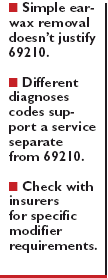Article
Coding Consult
Cerumen removal
Payers are notoriously difficult when you try to get reimbursed for an E&M service along with impacted cerumen removal. Although the circumstances and your documentation may justify reporting both an E&M service and the procedure, "insurers prefer not to pay for both," says Sharon Newman, Coding Education and Documentation Coordinator at Children's Specialty Group in Norfolk, VA.
But there are some strategies that can help you get paid for 99212-99215 services (office or other outpatient visit for the evaluation and management of an established patient . . .) in addition to 69210 (removal impacted cerumen [separate procedure], one or both ears). Here's what you need to know.
What justifies 69210?

For an encounter to qualify for code 69210, a physician must use instrumentation to remove impacted cerumen. You must use, at minimum, an otoscope and instruments, such as wax curettes, forceps, and suction. If you or your nurse removes the patient's earwax easily via irrigation or lavage, then you can't use code 69210. You should include the work in the appropriate level E&M code.
Assign separate diagnoses
To avoid a denial for the cerumen removal procedure, don't forget to include a diagnosis code describing what specific condition brought the patient to your office. Generally, the patient doesn't come in saying, "I'm here to have my cerumen removed."
Instead, the patient likely presents complaining of difficulty hearing in one or both ears, possible pain associated with impacted cerumen, and a possible sore throat due to eustachian tube involvement.
The work you do examining the patient and determining the appropriate course of action merits two diagnoses: one for the sick visit and the other for impacted cerumen removal. "Otherwise, the insurer will bundle the E&M service into 69210," Newman says.
The key is that your documentation must support two separate ICD-9-CM codes. "The only appropriate diagnosis to use with 69210 is 380.4-impacted cerumen," Newman says. The other diagnosis you'd use to support the E&M code may be ear pain (388.7x, otalgia), otitis media (381-382), or another illness (such as 465.9, acute upper respiratory infections of multiple or unspecified sites; unspecified site).
For example, say a patient comes in complaining of ear pain. You can't see the eardrum because of impacted cerumen, so you use an otoscope and curette to remove the impaction. Then you examine the ear and diagnose the patient with acute purulent otitis media.
In this case, the two diagnoses would be:
You should use the otitis media diagnosis (382.00) for the E&M service, and impacted cerumen (380.4) for the procedure. The different ICD-9-CM codes help show the insurer that you performed a separate E&M service from the cerumen impaction removal.





